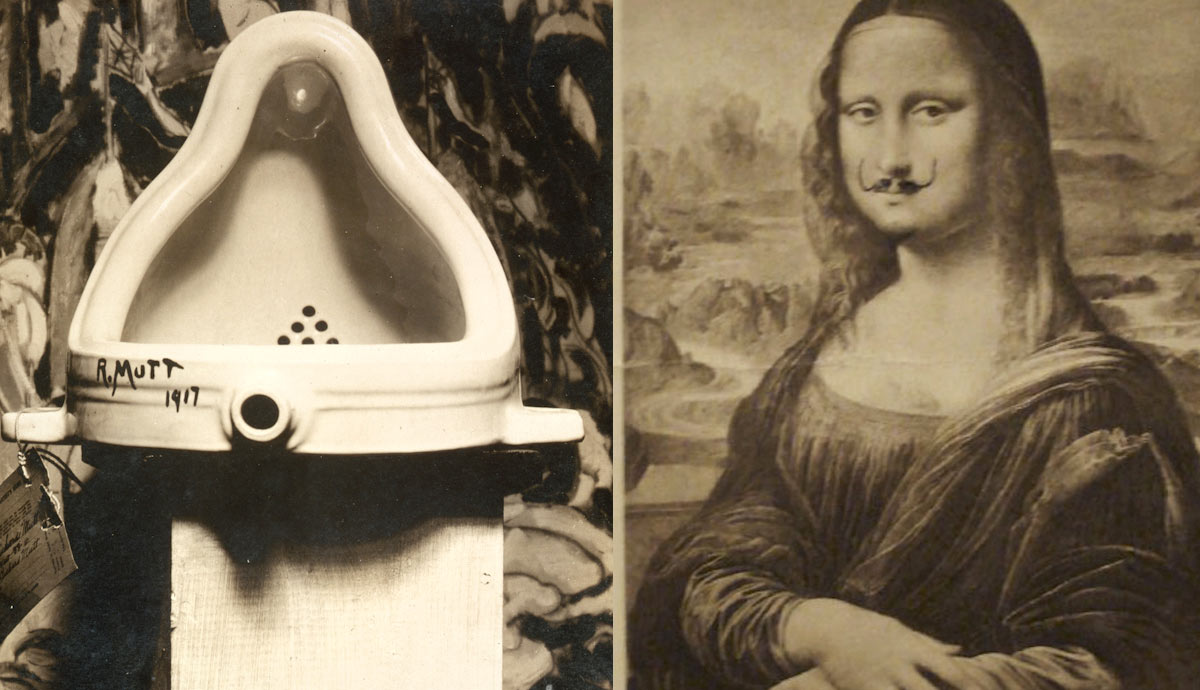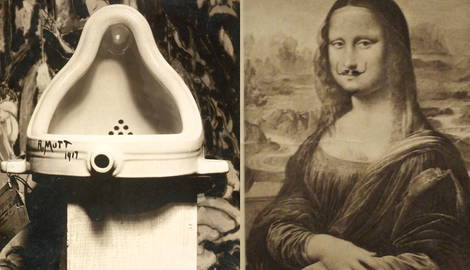
Marcel Duchamp is one of the most iconic artists of the 20th century. He revolutionized painting and sculpture in multiple ways. Although his first readymade dates from 1913, only in 1915 did he attribute a name to his idea. Even though his Fountain became the most (in)famous and controversial piece of art, many have come to know Duchamp for the mustache and beard he drew on the Mona Lisa, which was meant to stress the fact that academic art wasn’t more sacred than ordinary objects.
Who Was Marcel Duchamp?

Henri-Robert-Marcel Duchamp was one of the most prominent French artists who revolutionized the concepts of painting and sculpture at the beginning of the 20th century. He is most often associated with Cubism, Dadaism, and Conceptual art.
Duchamp’s artwork revolved around the belief that art was supposed to serve the mind and not the eye. He used to call the latter retinal art and sought to distance himself from it as much as possible. At the beginning of the 1910s, Duchamp started showing interest in transition, movement, and distance, which would later become quintessential in his artwork. In 1912, he painted Nude Descending a Staircase, No.2 which portrays, with elements from Cubism and Futurism, the mechanistic motion of the depicted nude.
During the same decade, Marcel Duchamp developed the concept of readymade, which he thought of as an antidote to retinal art. Marcel Duchamp made only a few original readymades but he also made numerous replicas. They still stand as his most unique artworks that stirred controversy and influenced generations of artists.
What Were Duchamp’s Readymades?

The term readymades refers to found objects Duchamp chose to turn into art. He usually did nothing to those objects except add his signature or play with their position, for example, as he did with the Fountain. Although some readymades caused disgust and laughter when first exhibited, they still stood as the world’s most provocative artworks. Readymades became the subject of fascination among many art theorists too. After all, Duchamp’s ordinary objects became the centerpieces of reevaluating the inadequacies of traditional criteria for art.
By exhibiting his readymades, which did not fit traditional criteria for art, Duchamp claimed them as pieces of art, which prompted theorists to ponder upon a very important question on the nature of art. Art, as a privileged, isolated category, no longer existed, according to Steven Goldsmith. When selecting the objects for his readymades, Duchamp made sure he approached them with complete indifference and a lack of aesthetic emotion.
Bicycle Wheel

Bicycle Wheel, sometimes called the first kinetic sculpture, was created in 1913 in Marcel Duchamp’s studio in Paris. Although it is now widely regarded as a readymade, some art critics and historians do not consider it a pure readymade. Duchamp mounted the wheel upside down onto a stool. He used to spin the wheel and watch it simply because he enjoyed looking at it. According to Duchamp, that wheel turning “was very soothing, very comforting, a sort of opening of avenues on other things than material life of every day.” The original Bicycle Wheel was lost, but this didn’t prevent Duchamp from creating other versions. The third version is a part of the collection of the Museum of Modern Art in New York.
Bottle Rack

The Bottle Rack readymade was created in 1914. It is considered the first pure readymade created by Marcel Duchamp. Just as its title implies, the artwork features a metal rack used for bottle drying. Some critics saw Bottle Rack as a piece showing sexual undertones due to its metal spikes, which, apparently, represented the male genitalia.
Duchamp apparently acquired that particular Bottle Rack from a store called Bazal de l’Hôtel de Ville in Paris. Other earlier readymades are not always considered pure readymades because they were slightly altered, but the Bottle Rack remained in its original form. There was only an inscription added on the side.
Duchamp moved to New York in 1915, while that particular bottle rack and other artworks remained in Paris. His sister, Suzanne Duchamp, had to take care of them. A year after arriving in New York, Duchamp wrote to his sister, telling her about the bottle rack. He asked if she could add the inscription to the piece and send it to him. Little did he know that Suzanne had thrown the bottle rack away. Therefore, the original version of the Bottle Rack was discarded by Duchamp’s sister. That particular object would later be sold for millions. However, Duchamp did not consider this to be a problem since the object was a mass-produced item. He created at least seven replicas, some of which are at the Art Institute of Chicago, the Norton Simon Museum, the Philadelphia Museum of Art, and the Moderna Museet.
In Advance of the Broken Arm

In Advance of the Broken Arm is also known as Prelude to a Broken Arm. This piece features a snow shovel with an inscription on its handle saying In Advance of the Broken Arm. The meaning behind its name points to the importance of the snow shovel in keeping oneself safe and sound. Without it, one would slip on ice or snow, fall, and break one’s arm. In his letter to his sister, Duchamp even advised her not to ponder upon the meaning of this readymade title. He advised her not to think of it in the Romantic, Impressionist, or Cubist sense since it had nothing to do with that. Duchamp bought the shovel at a hardware store. He then signed it and hung it from his studio ceiling. Like other readymades, that particular first shovel was lost. Its replica is now displayed at the Yale University Art Gallery.
Fountain

By far the most famous readymade is the Fountain. It has even been named the most influential artwork of the 20th century. It was created in 1917 and it features a porcelain urinal. The object was not altered but only repositioned. In addition, Duchamp also signed it using the name R. Mutt.
Duchamp bought the urinal from a sanitary ware supplier. He then added the inscription and submitted it to the Society of Independent Artists exhibition under the pseudonym R. Mutt. It was accepted because all submissions had to be accepted based on the Society’s constitution, however, they never put it on display. A few years before this event, Duchamp submitted his Nude Descending a Staircase, No. 2 to the Salon des Indépendants, but the organizers weren’t quite happy with it because of its title and subject. So, Duchamp had to withdraw the painting before the opening of the show.
As a consequence, art historians think that Duchamp might have wanted to test the Society’s openness toward freedom of expression by submitting this artwork under a pseudonym. He was also a member of the Society’s board, so he wanted to prevent biased opinion. Duchamp asked Alfred Stieglitz to photograph the Fountain. Since the original piece was eventually lost, the photograph taken on the 19th of April 1917 stands as one of the most important art-related documents of the 20th century.
L.H.O.O.Q.

L.H.O.O.Q. is what specialists call a rectified readymade. It consists of a postcard portraying Leonardo da Vinci’s Mona Lisa. However, there’s something different here. Duchamp gave the Mona Lisa a mustache and a beard. The title is a gramogram, meaning that the letters are arranged in a way that, pronounced together, forms one or more words. For example, CU is read as see you. Duchamp’s gramogram ends up sounding like the words Elle a chaud au cul in French. This is a vulgar expression that translates as She is hot in the arse, although Duchamp once used a slightly more formal translation: There is fire down below.
At first, L.H.O.O.Q seemed to outrage people because it was seen as an attack on the original Mona Lisa and traditional art generally. Over the years, however, critics pointed to Duchamp’s attempt of gender reversal by masculinizing the woman. Considering that the Mona Lisa had been seen as the representation of ideal feminine beauty for hundreds of years, Duchamp’s prank, as some call it, challenged that concept.

As Duchamp himself stated, his readymade was an interpretation of the painting—Mona Lisa became a man, and not simply a woman disguised as a man, but a man in the truest meaning of the word. Many historians believed da Vinci was gay. It has even been suggested that by painting women, Leonardo da Vinci obscured his sexuality. In fact, some researchers argue that Mona Lisa was actually inspired by Gian Giacomo Caprotti, a possible lover of da Vinci, and by Lisa Gherardini, the wife of a rich Florentine merchant. Silvano Vinceti claims that the Mona Lisa is androgynous, meaning it’s part male and part female. Leonardo da Vinci thought that a perfect person would be seen in a combination of a man and a woman. Considering this, Marcel Duchamp only did the artwork a favor. He simply helped the hidden male characteristics resurface.
Belle Haleine, Eau de Voilette

Belle Haleine, Eau de Voilette translates as Beautiful Breath, Veil Water. This assisted readymade was created by Duchamp in 1921 in collaboration with Man Ray. It consists of a Rigaud perfume bottle with the label completely modified. The R of the label became RS reflected in a mirror. The model was replaced with a portrait of Rrose Sélavy, Duchamp’s feminine alter ego. This name had first been used a year before in the signature of another readymade called Fresh Widow. Now, Duchamp went even further by displaying a photo of Rrose that was taken by Man Ray. The original label read Eau de Violette and Un air embaumé (translated as Violet Water and perfumed air), but Duchamp’s version read Belle Haleine and Eau de Voilette (Beautiful Breath and Veil Water). Since Fountain is Duchamp’s most famous piece, you’ll be surprised to learn that Belle Haleine, Eau de Voilette surpassed its price. It was sold at auction for 8,913,000 euros.










